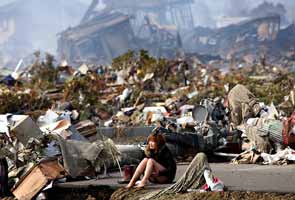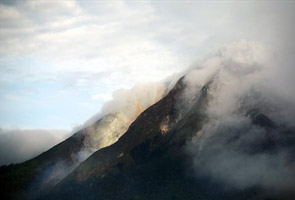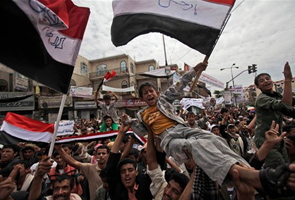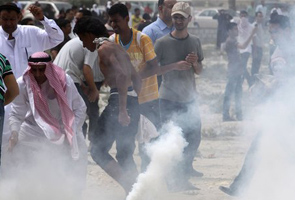Natori, Japan: One couple rode out the tsunami on top of an irrigation tower, crammed in with three other people. A man had to abandon his car in a field and run for it. Another couple simply got lucky, riding out the torrents in their house, one of the few in a swath of destruction that inexplicably held together.
They began streaming back to this stricken rice farming town on Monday morning, long lines of people returning to see what, if anything, was left of their lives after the waves came. They walked slowly, gazing in bewilderment at a scene that they could only struggle to comprehend.
Officials said the death toll in Friday's tsunami was certain to exceed 10,000. But even that seemed conservative -- a leading Japanese daily reported Monday that 20,000 people in two small coastal towns were missing.
Many returning here Monday were in tears. One couple said between sobs that they were trying to find their elderly mother, whom they had been forced to leave behind. There were many older people in the area, residents said, and many of them were trapped in their houses.
Until last week, Natori's farmers had tilled fields of rice in the summer and, in the winter, vegetables in neat white rows of plastic greenhouses, fields that most of the world saw inundated on Friday by a wall of water, mud, cars and wooden debris.
The devastation extends miles inland, so much so that even some evacuation centers were reportedly engulfed. In satellite images, Natori and nearby Yuriage, just south of the battered city of Sendai, seem to have been swept away without a trace, as if a giant razor had shaved the earth clean.
Kayo Miura said she was upstairs at her house when the earthquake struck, knocking her off her feet. She turned on the radio and heard a tsunami alert, but she had heard those before and nothing had come of them. After all, she thought, the house was almost two miles from the beach.
About 20 to 30 minutes later, she said, she saw a line of cars on her field. "Why are those cars parked in the field?" she wondered. Then she saw them moving, heard screams about a tsunami coming and froze. Her husband, Ken, ran upstairs just as the waves hit. Inexplicably, in an area where virtually every house was destroyed, theirs held together.
Others told harrowing tales of escape. When Naoko Takahashi, 60, and her husband, Hiromichi, 64, saw a jumble of cars and burning fuel bearing down on them, they ran as fast as they could, but the menacing wall kept gaining. Not sure what to do, they caught sight of an irrigation tower that was 12 to 15 feet high and scrambled up just in time, joining two others in riding out the flood.
"The only reason we made it were some earthen walls that slowed the water just enough," Mr. Takahashi said. "They gave us a few seconds."
They made their way home after dark, they said, wading through water that was up to their armpits while fires burned all around. The next day, some soldiers came and took them to a shelter.
As they got home, Ms. Takahashi turned to her husband and said: "Look, there's our house. What is that boat?" Indeed, there was a fishing boat sitting in a rice paddy to the side of their house.
The gloom was occasionally pierced by a ray of humor, of the gallows sort. Ko Miura, 56, a wholesaler, said he tried to drive home after the quake. But he was driving parallel to the wave, so he was forced to abandon his car and run. He just managed to get to a highway overpass before the waters swept by. When he looked up, he said, he saw his car float by.
The immediate future for Natori and its residents is undoubtedly grim. Rescue workers have been hampered by quake-damaged roads and debris, enormous traffic jams and fuel shortages. After a spell of relatively mild weather, temperatures were dropping and snow was in the forecast.
And even as people picked through what little was left in the rubble, the fires continued to burn.
 New Delhi: India has put in place an effective system to issue Tsunami alerts after the catastrophe had hit country in 2004, a senior government official said.
New Delhi: India has put in place an effective system to issue Tsunami alerts after the catastrophe had hit country in 2004, a senior government official said. 


 Beijing: China on Monday rejected any comparison between itself and the Middle East and North African countries where popular uprisings toppled autocrats.
Beijing: China on Monday rejected any comparison between itself and the Middle East and North African countries where popular uprisings toppled autocrats. 



 Click to Expand & Play
Click to Expand & Play





























 One of the most enigmatic Android handsets in Verizon's line-up has been the HTC Droid Incredible. With incredible demand hitting Verizon right off the bat, the handset was on back order almost immediately after launch, partially due to Samsung's inability to keep up with production of AMOLED screens. Eventually, HTC switched to Super LCD displays, but by then it was too late for the unit to regain the momentum it once had and by then, the Motorola DROID X had taken over flagship status at Big Red.
One of the most enigmatic Android handsets in Verizon's line-up has been the HTC Droid Incredible. With incredible demand hitting Verizon right off the bat, the handset was on back order almost immediately after launch, partially due to Samsung's inability to keep up with production of AMOLED screens. Eventually, HTC switched to Super LCD displays, but by then it was too late for the unit to regain the momentum it once had and by then, the Motorola DROID X had taken over flagship status at Big Red.



